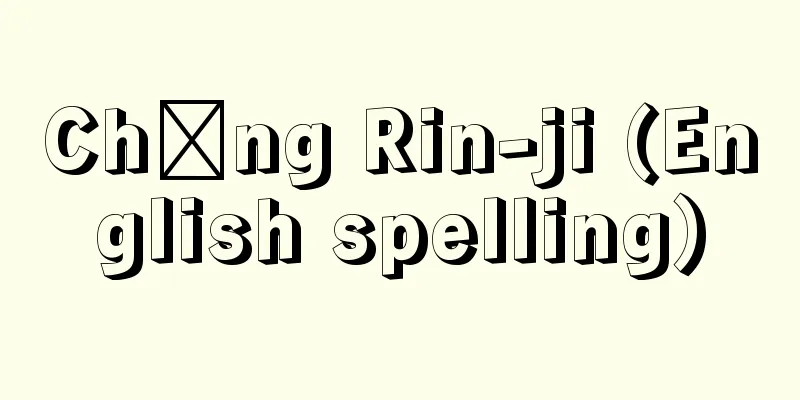Electric locomotive - Electric locomotive

|
A self-propelled railway vehicle made for pulling passenger or freight cars. It has no passenger compartment, luggage compartment, or cargo room. Electricity is collected from overhead lines or a third rail (a rail that runs along the track), and the return current is returned to the rail. Generally, it is equipped with a larger motor than an electric train (up to about 1,600 kilowatts), and the bogie structure is different from that of an electric train to maximize traction performance. Electrical systems include direct current, single-phase alternating current, and three-phase alternating current, and the voltage and frequency vary depending on the railway. In Japan, suburban railways in major cities such as Tokyo and Osaka, and the Tokaido Line use 1,500 volts direct current, while the Kagoshima Main Line and Hokuriku Main Line use 20 kilovolts and 60 hertz alternating current, while the Joban Line (north of Fujishiro), Tohoku Main Line (north of Kuroiso), and Hakodate Main Line use 20 kilovolts and 50 hertz alternating current. Depending on the electrical system of the line they run on, there are DC electric locomotives, AC electric locomotives, and AC/DC (dual-purpose) electric locomotives equipped with a switching device that allows direct operation on both AC and DC sections. In Europe, each country has its own AC and DC, and the voltage and frequency of the AC can also differ, so electric locomotives equipped with multi-power source switching equipment are used for international direct operation. [Gentaro Nishio and Yoshihiko Sato] structureIt consists of bogies and car body, current collector (pantograph), main control device, electric motor and drive device, electric blower for cooling the electric motor, motor generator, auxiliary equipment control device, air brake device, driver's cab and operation control device, measuring instruments, etc. Some passenger electric locomotives are equipped with train heating devices. There are two methods for towing passenger and freight cars: (1) a method in which power is transmitted from the bogie to the car body via a center plate or a pulling bar, and towed by a coupler at the end of the car body, and (2) a method in which a coupler is attached to the bogie and towed independently of the car body. Until the 1950s, the method (2) of directly connecting the bogie was common, but since the 1960s, the method (1) has been widely adopted worldwide because it requires the bogie to be strong and increases its weight. In Japan, the EF65 type is an example of (1), and the EF58 type is an example of (2). In most cases, the main motor and gear reduction gear for driving are mounted on the bogie, while other equipment is stored in the equipment room inside the car body. Therefore, although there are small electric locomotives with a convex type with a cab in the center, most are of the double cab type with a cab at each end of the box-shaped car body. In Europe, for mountain lines and heavy freight, there are convex types with equipment rooms on the decks at both ends, and there were also large ones commonly called crocodile type, but nowadays, with the advancement of technology to reduce size and weight, the box type has become the standard car body shape. [Gentaro Nishio and Yoshihiko Sato] Operation and power system [1] DC motor drive (2) AC electric locomotives The collection voltage for Japan's conventional railways is 20 kV, 50 Hz or 60 Hz single-phase AC. In Europe, 25 kV, 50 Hz or 15 kV, 16 2/3 Hz single-phase AC is the norm, while in the United States, 11 kV, 25 Hz single-phase AC is the norm. In South Africa, the United States, and Canada, 50 kV, 50 Hz single-phase AC is used on heavy freight lines for ore and other cargo. Control methods are broadly divided into direct and rectifier types. In the direct type, the voltage is lowered by a main transformer on the vehicle and the AC commutator motor is driven directly. In the rectifier type, the voltage is lowered to a certain extent by the main transformer, and then converted to DC with less pulsation by a main rectifier and smoothing reactor to drive the DC motor; most Japanese AC electric locomotives up until the 1990s used this type. Mercury rectifiers were used when AC electrification was first developed in the early 1960s, but they have since been replaced by semiconductor-type silicon rectifiers. Speed control, which was previously performed by tap changing on the transformer, has now been replaced by a method that continuously converts voltage through phase control using thyristors. [2] AC motor drive To control the rotation speed and torque of AC induction motors, a VVVF inverter was developed that converts collected direct current into three-phase alternating current and continuously controls the voltage and frequency. This made it possible to use AC induction motors as main motors, and was adopted in Switzerland, Germany, and Japan. Meanwhile, France lagged behind in the development of inverters, and used synchronous motors, which can be controlled by simple inverters, as main motors. Induction motors have coils arranged in a cage shape on the rotor, and generate torque by inducing current in the rotor coil with the rotating magnetic field from the field coil. The structure of the motor is simple, but in order to convert direct current to three-phase alternating current, the inverter needs to use high-speed elements with high current switching speed. On the other hand, synchronous motors supply direct current from the outside to the rotor through a commutator to create an electromagnet, which is attracted by the rotating magnetic field of the field coil to generate torque. Although the structure of the motor is complicated, the inverter does not need to use high-speed elements because the counter electromotive force generated in the motor when converting direct current to three-phase alternating current can be utilized. The French National Railways adopted synchronous motors for the 26000 series AC/DC electric locomotives and the TGV-A. Since then, the development of high-speed switching elements has improved the performance of inverters and reduced their prices, so induction motor-driven locomotives have been manufactured. With the introduction of AC motor drive, there is virtually no difference between DC and AC electric locomotives. Apart from the main transformer and AC to DC converter, the inverter and main motor are the same for both. European manufacturers produce DC, AC and AC/DC locomotives with the same performance and major components in common. VVVF inverter-controlled AC induction motor drive has been used on both DC and AC electric locomotives since the mid-1980s. [Gentaro Nishio and Yoshihiko Sato] History and current situationThe first idea was recorded in 1834 when American Thomas Davenport (1802-1851) created a model that ran on batteries. In 1879, Germany's E. W. Siemens successfully tested the first practical vehicle in Berlin. In Japan, the Usui Pass Abt geared rail section between Yokokawa and Karuizawa on the Shinetsu Main Line was electrified in 1912 (Meiji 45), and commercial operation began with 12 10000 series (later renamed EC40 series) cars manufactured by the German Allgemeine Elektricitäts-Gesellschaft (AEG). In 1919 (Taisho 8), the first domestically produced electric locomotive, the ED40 series, manufactured by the then Railway Bureau Omiya Works (now JR East Omiya General Rolling Stock Center), was added to this section. In 1922, the Imperial Diet approved the electrification plan for the Tokyo-Kobe section, and the adoption of electric locomotives began in earnest. From that year through the early Showa period, several types of electric locomotives were imported from four countries that were advanced in electric locomotive technology: the United States, the United Kingdom, Germany, and Switzerland. In 1926, Hitachi manufactured three prototype medium-sized electric locomotives (later the ED15 type) and tested them together with imported electric locomotives. These electric locomotives were also delivered to the Nagano Electric Railway and the Nanbu Railway. Building on this accumulated technology, the EF52 type, Japan's first large electric locomotive of the Ministry of Railways standard, was completed in 1928 (Showa 3). The Tokaido Main Line was electrified between Tokyo and Kozu at the end of 1925, and electrification was completed up to Atami in 1928. In 1931, the Joetsu Line between Minakami and Ishiuchi and the Chuo Line between Hachioji and Kofu were electrified, and domestic production became established with the development of the ED16 medium-sized electric locomotive for steep mountain gradients. Due to the impact of World War II, the electrification of the nation's main lines was postponed until after the war, but large electric locomotives became the main product of Japan's major heavy electrical equipment manufacturers, and the postwar electrification of railways contributed greatly to the reconstruction of the industry. In the 1950s, the development of AC electrification technology progressed at JNR, and after various prototypes, the first mass-produced AC electric locomotive, the ED70 type, appeared on the Hokuriku Main Line between Tamura and Tsuruga in 1957 (Showa 32). AC electric locomotives subsequently evolved from the mercury rectifier type to the silicon rectifier type, and dual-purpose electric locomotives such as the EF80 type, which could operate directly on DC electrified sections, began to be manufactured. Furthermore, with the advancement of technology to strengthen adhesion around driving wheels, EF63 type DC electric locomotives began to be used as auxiliary locomotives specially for steep gradients on the Usui Pass on the Shinetsu Main Line, which previously used the Abt gear rail (the Usui Pass section (Yokokawa-Karuizawa) was abolished in 1997 with the opening of the Nagano Shinkansen). Electric locomotives have been developed mainly in European countries with abundant hydroelectric power, such as Switzerland, Sweden, Germany, and Italy. These were powered by three-phase AC, low-frequency (16 2/3 Hz) AC, or DC. After World War II, France began to seriously research commercial frequency AC electrification around 1950, and in 1954, AC electrification was completed on the northern trunk line of the heavy industrial area along the Belgian border. Furthermore, the SNCF's 1,500-V DC electric locomotive, which recorded a top speed of 331 km/h in March 1955, along with commercial frequency electrification, made the potential of electric railways known around the world, and became the catalyst for Japan's Shinkansen and France's TGV. While these adopted DC motors for driving, the German Federal Railway (now Deutsche Bahn) pursued the possibility of commutator-free induction motor drive, and mass-produced the powerful multi-purpose electric locomotive E120 type driven by a VVVF inverter-controlled AC induction motor from 1983. This resulted in improved adhesion (friction) between the wheels and the rails and increased motor power. This prompted various countries to develop locomotives driven by AC induction motors or synchronous motors, resulting in motors with outputs of 1000 kilowatts for narrow gauge (1067 mm) and 1600 kilowatts for standard gauge, and DC motors were no longer manufactured. Due to advances in power electronics, VVVF-controlled induction motor drives using IGBT elements have become widespread since 2000, replacing GTO elements. GTO elements are thyristor-based elements that require snubber circuits to switch the current on and off, and the switching speed is limited to a few hundred hertz, resulting in large equipment volume. With the practical application of transistor-based IGBTs, switching speeds have increased to several kilohertz, and snubber circuits are no longer necessary, resulting in smaller equipment. In addition, technologies such as vector control and creep control have made it possible to make maximum use of adhesion between the wheels and the rails. With the development of these new technologies, the importance of electric locomotives as a driver of higher speeds and greater transport capacity is expected to increase. In Japan, long-distance trains have been replaced by Shinkansen trains, and commuter trains in major cities have been replaced by electric trains, so the presence of electric locomotives is no longer of much importance, but in Europe and Asia, passenger trains pulled by electric locomotives are the norm. Both long-distance and commuter trains pull up to twenty or so passenger cars and are the main form of transportation. Electric locomotives, along with electric trains, are considered to be the main form of railways in the future for the following reasons. (1) In addition to hydroelectricity and oil, a variety of other energy sources can be used for electricity. (2) It is highly energy efficient, and can save electricity, especially through regenerative braking, which allows the electric motor to act as a generator during braking. (3) Since electric motors receive energy from an external source, it is easier to produce large output than other power sources. They are capable of high-speed operation under any track conditions and have large output, and their speed characteristics are particularly excellent when climbing steep slopes. (4) Unlike other powered vehicles, it does not need to carry fuel, water, etc., so there is no need for extra weight or crew effort, and the operating efficiency of both the vehicle and the crew is high. (5) It does not emit soot or exhaust fumes, so it does not pollute the areas along the line or in the passenger compartment. (6) Inspection and repair are easy, so vehicle maintenance costs are low and labor is saved. On the other hand, there are also the following disadvantages: (1) The scope of use is limited to electrified sections. (2) Because investment in electrified railway lines is expensive, it is difficult to expand electrification to the entire area in sections with low traffic volume or long sections such as transcontinental railroads. (3) If the ground electrical equipment fails, the entire area may become inoperable. (4) It is not suitable for tasks where overhead lines would get in the way, such as switching trains or removing snow within a premises. However, in order to reduce CO2 emissions and diversify energy sources, electrification is being promoted in Europe and Asia, where passenger and freight rail transport volumes are large. China and India, which are experiencing particularly rapid economic growth, are electrifying hundreds of kilometers of rail every year. In these regions, the use of electric locomotives is on the rise. [Gentaro Nishio and Yoshihiko Sato] "Outline of AC Electric Vehicles" by Yuji Kawazoe (1971, Electric Vehicle Research Society) [Reference] | | | | | | | | |©Toshihisa Watanabe "> Structure of electric locomotive (EF66 type) Source: Shogakukan Encyclopedia Nipponica About Encyclopedia Nipponica Information | Legend |
|
客車あるいは貨車を牽引(けんいん)する目的で製造された、電動機により自走する鉄道車両。客室、荷物室あるいは貨物室を有しない。電力は架線あるいは第三軌条(線路に沿う集電用レール)から集電し、帰線電流はレールに返している。一般的には電車よりも大きい電動機(最大1600キロワット程度)を搭載し、牽引性能を最大限発揮できるように台車の構造も電車のものとは異なっている。電気方式は、直流、単相交流および三相交流があり、鉄道によって電圧や周波数が異なっている。日本では東京や大阪などの大都市近郊鉄道、東海道線などが直流1500ボルト、鹿児島本線、北陸本線などが交流20キロボルト60ヘルツ、常磐線(藤代以北)、東北本線(黒磯以北)、函館本線などが交流20キロボルト50ヘルツとなっている。走行する線区の電気方式に対応して、直流電気機関車、交流電気機関車、交流・直流の両区間を直通運転ができる切換え装置を備えた交直流(両用)電気機関車がある。ヨーロッパでは国によって交流・直流の別があり、電圧や交流の周波数も違うことがあるので、国際直通運転のために多電源切換えの設備をもつ電気機関車が使用される。 [西尾源太郎・佐藤芳彦] 構造台車と車体、集電装置(パンタグラフ)、主制御装置、電動機および駆動装置、電動機冷却用の電動送風機、電動発電機、補助機器制御装置、空気ブレーキ装置、運転台と運転制御機器、計測器などで構成されている。旅客用電気機関車には列車暖房装置を設備しているものもある。 客貨車を牽引する方式として、(1)台車から心皿または引張り棒を介して車体に力を伝え、車体の端の連結器で牽引する方式と、(2)台車に連結器が付き、車体に関係なく牽引する方式とがある。1950年代までは(2)の台車直結方式が多かったが、台車を強固にする必要があって重量が増えるので、1960年代以降は(1)の形式が世界的に広く採用されている。日本では(1)にはEF65形など、(2)にはEF58形などがある。 駆動用の主電動機と歯車減速装置はほとんどの場合台車に装荷されるが、他の機器は車体内の機器室に収納する。したがって、小型では中央に運転室のある凸型電気機関車もあるが、多くは箱型車体の両端に運転室を配した両運転室型である。ヨーロッパの山岳線用、重量貨物用には両端のデッキにあたる部分にも機器室がある凸型で、俗にクロコダイル(ワニ)型とよばれる大型もあったが、現在では小型・軽量化技術が進歩して箱型が標準の車体形状になっている。 [西尾源太郎・佐藤芳彦] 運転と電力方式〔1〕直流電動機駆動 (2)交流電気機関車 日本の在来線の集電電圧は20キロボルト50ヘルツまたは60ヘルツ単相交流である。ヨーロッパは25キロボルト50ヘルツまたは15キロボルト16 2/3ヘルツ単相交流、アメリカは11キロボルト25ヘルツ単相交流が主である。南アフリカ共和国や、アメリカ、カナダの鉱石などの重量貨物専用線には50キロボルト50ヘルツ単相交流が使われている。 制御方式は直接式と整流器式に大別された。直接式では車両上の主変圧器で電圧を下げ、そのまま交流整流子電動機を駆動する。整流器式は、主変圧器である程度降圧したあと、主整流器と平滑リアクトルで脈動の少ない直流に変えて直流電動機を駆動する方式で、1990年代までの日本の交流電気機関車はほとんどこの方式である。交流電化開発当初の1960年代前半には水銀整流器が使われていたが、半導体式のシリコン整流器にかわった。また変圧器のタップ切換えによって行っていた速度制御も、サイリスタを使用しての位相制御によって電圧を連続的に変換する方式が採用されるようになった。 〔2〕交流電動機駆動 交流電動機駆動により、直流電気機関車と交流電気機関車の実質的な差はなくなった。主変圧器と交流を直流に変換するコンバーターを除けば、インバーター、主電動機は両者共通である。ヨーロッパのメーカーは、おもなコンポーネントを共通とした同じ性能の機関車を、直流、交流および交直流として製造している。VVVFインバーター制御交流誘導電動機駆動は、1980年代半ばから、直流、交流電気機関車にかかわりなく、採用されるようになった。 [西尾源太郎・佐藤芳彦] 歴史と現状1834年、アメリカのダベンポートThomas Davenport(1802―1851)が電池で走行する模型をつくった記録が最初の発想である。1879年、ドイツのE・W・ジーメンスが初めてベルリンで実用車の試験に成功した。日本では1912年(明治45)、信越本線横川―軽井沢間の碓氷(うすい)峠アプト式歯車軌条区間が電化され、ドイツのアルゲマイネ社(AEG:Allgemeine Elektricitäts-Gesellschaft)製の10000形(のちEC40形と改称)12両で運行を開始したのが営業運転の始まりで、この区間には1919年(大正8)当時の鉄道院大宮工場(現JR東日本大宮総合車両センター)製の最初の国産電気機関車ED40形が増強された。1922年、東京―神戸間の電化計画が帝国議会で承認され、電気機関車の採用が本格的に始動した。その年から昭和の初年にかけて、電気機関車技術の先進国だったアメリカ、イギリス、ドイツ、スイスの4か国から数種類の電気機関車が輸入された。1926年には日立製作所が3両の中型電気機関車(後のED15形)を試作して輸入電気機関車とともにテストされ、同型電気機関車は長野電鉄、南武鉄道にも納入された。この技術蓄積のうえに、日本初の鉄道省標準型大型電気機関車EF52形が完成したのが1928年(昭和3)である。東海道本線は1925年暮れに東京―国府津(こうづ)間が電化され、1928年には熱海(あたみ)までの電化が完了した。1931年には上越線水上(みなかみ)―石打間、中央本線八王子―甲府間が電化され、山岳急勾配(こうばい)用の中型電気機関車ED16形の開発により国産化も定着した。 全国幹線の電化は第二次世界大戦の影響もあって戦後に持ち越されたが、大型電気機関車は日本の大手重電メーカーの主力製品となり、戦後の鉄道電化は業界再建に大きく貢献した。1950年代には国鉄における交流電化の技術開発が進み、各種の試作を経て1957年(昭和32)に北陸本線の田村―敦賀(つるが)間に本格的量産機の交流電気機関車ED70形が登場した。交流電気機関車はその後、水銀整流器式からシリコン整流器式に発展し、また直流電化区間にも直通運転ができるEF80形などの交直流両用電気機関車がつくられるようになった。また、動輪周の粘着力強化技術の進歩に伴って、アプト式歯車軌条を用いていた信越本線碓氷峠にEF63形直流電気機関車が急勾配専用補機として使用されるようになった(1997年、長野新幹線開業に伴い碓氷峠区間(横川―軽井沢)は廃止された)。 電気機関車は水力電気の豊富なスイス、スウェーデン、ドイツ、イタリアなどのヨーロッパ諸国を中心に発達してきた。これらは三相交流、低周波数(16 2/3ヘルツ)交流あるいは直流を電源としていた。第二次世界大戦後は、1950年ごろからフランスが商用周波数交流電化を本格的に研究し、1954年にベルギー国境に沿う重工業地帯の北部幹線の交流電化を行った。さらに、フランス国鉄が1955年3月に最高時速331キロメートルを記録した直流1500ボルトの電気機関車は、商用周波数電化とあわせて電気鉄道の可能性を世界各国に知らしめ、日本の新幹線やフランスのTGV(テージェーベー)の契機となった。これらが直流電動機を駆動用として採用していたのに対し、ドイツ連邦鉄道(現ドイツ鉄道)は整流子のない誘導電動機駆動の可能性を追求し、1983年からVVVFインバーター制御交流誘導電動機駆動による強力多用途電気機関車E120形を量産した。これにより、動輪とレールの粘着(摩擦力)性能向上と電動機の大出力化が達成された。これを契機とし、各国は交流誘導電動機あるいは同期電動機駆動の機関車開発を進め、狭軌(1067ミリメートル)でも1000キロワット、標準軌でも1600キロワットの出力の電動機が登場し、直流電動機駆動の機関車は製造されなくなった。パワーエレクトロニクスの進歩により、2000年以降はGTO素子に代わってIGBT素子を使用したVVVF制御誘導電動機駆動が広く普及している。GTO素子はサイリスターベースの素子であり、電流のオンオフ(スイッチング)のためスナバー回路を必要とし、スイッチング速度も数百ヘルツにとどまり、機器の容積が大きくなっていた。トランジスターベースのIGBTが実用化され、スイッチング速度も数キロヘルツと高くなり、スナバー回路も不要となったので、機器が小型になった。また、ベクトル制御、クリープ制御などの技術により車輪とレール間の粘着も最大限利用できるようになった。これらの新しい技術の開発によって、高速化と大輸送能力の推進役としての電気機関車の重要性はますます増大するものと思われる。 日本では、長距離列車は新幹線電車に、大都市近郊列車も電車に置き換わって、電気機関車の存在はあまり意識されなくなっているが、ヨーロッパ、アジアでは、電気機関車牽引の客車列車が主力である。長距離列車、近郊列車ともに二十数両におよぶ客車を牽引して輸送の主力となっている。電気機関車が、電車とともに今後の鉄道の主力と考えられるのは、次のような特徴によってである。 (1)電力のエネルギー源として水力、石油のほかに多様なものを使うことができる。 (2)エネルギー効率が高く、とくにブレーキ時に電動機を発電機として作用させる電力回生ブレーキによって電力を節約できる。 (3)電動機は、エネルギーを外部から供給されるので、大きな出力とすることが他の動力機関に比べて容易であり、どんな線路条件でも高速運転が可能で出力も大きく、とくに急勾配の登坂の速度特性が優れている。 (4)他の動力車のように燃料・水などを搭載しないですむので余分な負担重量や乗務員の労力が不要で、車両も乗務員も運用効率が高い。 (5)煤煙(ばいえん)や排気ガスを発生しないので、沿線や客室を汚染しない。 (6)検査や修繕が容易で車両維持費が安く省力化が可能である。 その反面、次のような短所もある。 (1)使用範囲が電化区間に限定される。 (2)路線の電化設備投資が高価なので、輸送量の少ない区間や大陸横断鉄道のような長い区間では全域の普及がむずかしい。 (3)地上電気設備が故障すると全域が運転不能になることがある。 (4)構内での入換えや除雪のように、架線がじゃまになる作業には向かない。 しかし、CO2削減やエネルギー源の多様化のため、旅客・貨物の鉄道輸送量の大きいヨーロッパやアジアで電化が進められている。とくに経済成長の著しい中国やインドは、毎年数百キロメートルの電化を行っている。これらの地域で、電気機関車は増加傾向にある。 [西尾源太郎・佐藤芳彦] 『川添雄司著『交流電気車両要論』(1971・電気車研究会)』 [参照項目] | | | | | | | | |©渡部利久"> 電気機関車の構造(EF66形) 出典 小学館 日本大百科全書(ニッポニカ)日本大百科全書(ニッポニカ)について 情報 | 凡例 |
<<: Electric meter - Electric meter
>>: Electrical machinery industry
Recommend
Massif de l'Aïr
Granite mountain range in central Niger. Located i...
"Educational Theory" - Kyoikuron
…Up until this time, patriarchy was barely suppor...
Tamandua tetradactyla (English spelling)
...General term for mammals of the Myrmecophagida...
Virbius (English spelling)
An ancient Italian god. He was worshipped together...
Portativ
…There are various sizes of organs depending on t...
Mobutu Sese Seko
Born October 14, 1930 in Lissara, Belgian Congo. D...
Annular gland - Kanjosen
…In Lepidoptera, the prothoracic gland is a pair ...
Kamikura-so
This royal manor was headquartered at Saishoko-in ...
Kineya - Kineya
The family name of Nagauta shamisen players. It be...
Temperature - Kion
This refers to the temperature of air. It is expr...
Sekiden (English spelling)
In China, this is an agricultural ritual to encour...
Teatr “Vanemuine” - Teatr “Vanemuine”
...The theater of the Baltic peoples is heavily i...
Beja tribe - Beja tribe (English spelling)
In Arabic, they are called Bujah. They are a nomad...
Electrolytic polishing - Denkaikenma
This is a distortion-free polishing method in whi...
Chauliops fallax
...The giant stink bug Piocoris varius and the lo...









